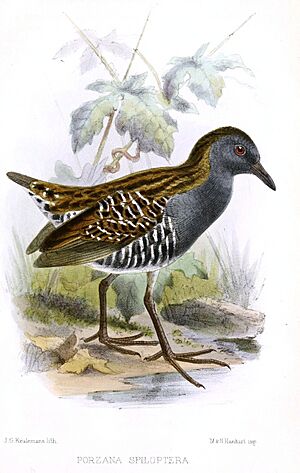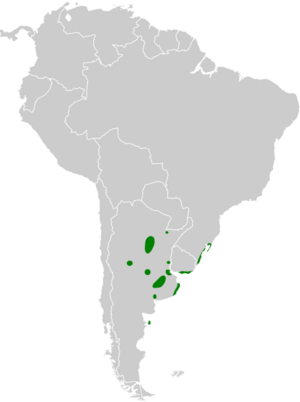Dot-winged crake facts for kids
Quick facts for kids Dot-winged crake |
|
|---|---|
 |
|
| Conservation status | |
| Scientific classification | |
| Genus: |
Laterallus
|
| Species: |
spiloptera
|
 |
|
| Synonyms | |
|
|
The dot-winged crake (Laterallus spiloptera) is a small bird that belongs to the rail family, Rallidae. This family includes rails, gallinules, and coots. The dot-winged crake lives in parts of South America, including Argentina, Brazil, Chile, and Uruguay. It is considered a vulnerable species, which means its population is at risk.
Contents
About the Dot-winged Crake
What it Looks Like
The dot-winged crake is a small bird, usually about 14 to 15 centimeters (about 5.5 to 6 inches) long. Both male and female birds look very similar. Their upper parts are dark olive-brown with black stripes. They have some white markings on their flight feathers, which are the main feathers used for flying. Their face and chest are dark gray. The feathers under their tail are striped black and white.
Where it Lives
The dot-winged crake is found in southern Uruguay and northern Argentina. Some experts also say it lives in Brazil's southernmost state, Rio Grande do Sul, and in Chile. You can find records of this bird in all four countries.
This crake likes to live near water. It can be found in freshwater marshes, swamps, and wet grasslands. It also lives in areas with salty water, like tidal marshes. Sometimes, it is seen in drier grasslands and areas along rivers.
Behavior and Habits
How it Moves
Scientists do not know much about how the dot-winged crake moves around. It is not known to migrate or travel long distances.
What it Eats
The dot-winged crake eats a variety of things. Its diet includes insects, seeds, and plants found in marshes. How it finds its food is not well-documented.
Breeding and Nests
Only one nest of a dot-winged crake has ever been found, near Buenos Aires, Argentina. Because of this, very little is known about how these birds raise their young.
Sounds it Makes
The dot-winged crake has a special song. It starts with a high note, then follows with a lower, rattling sound. It sounds like "kee-krrrrr" and is repeated several times. It also makes other calls, like a soft "pwup" and a scolding rattle.
Why it's Vulnerable
The dot-winged crake is listed as a vulnerable species by the IUCN (International Union for Conservation of Nature). This means its population is decreasing and it faces threats.
Its habitat, which is usually small and spread out, is shrinking. Experts believe there are only about 2,500 to 10,000 adult birds left. The biggest threat to the dot-winged crake is the loss of its wetland homes. These wetlands are often changed into farmland, especially for grazing animals. This can involve burning parts of the land. Other wetlands have been flooded, which also destroys their habitat.
The bird lives in a few protected areas. However, more surveys are urgently needed to find out exactly where these birds live within their limited range. This will help protect them better.


